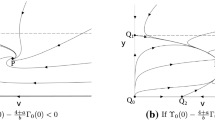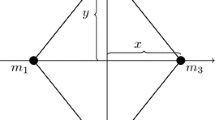Abstract
A nearly dynamically symmetric rigid body is considered. An approximation of this body by a system of two homogeneous balls is studied, such that the components of the Euler–Poinsot tensor of the original body and its approximation coincide up to the third order and the moments of inertia of the body are well approximated by the moments of inertia of the system of two balls. Asteroids 1620 Geographos and 25143 Itokawa are considered as examples.
Similar content being viewed by others
REFERENCES
M. D. Kislik, “Motion of an artificial satellite in the Earth’s normal gravity field,” Iskusstv. Sputniki Zemli, No. 4, 3–17 (1960).
M. D. Kislik, “Analysis of integrals of the equations of motion of an artificial satellite in the Earth’s normal gravity field,” Iskusstv. Sputniki Zemli, No. 13, 23–52 (1963).
E. P. Aksenov, E. A. Grebenikov, and V. G. Demin, “The generalized problem of motion about two fixed centers and its application to the theory of artificial Earth satellites,” Sov. Astron. 7 (2), 276–282 (1963).
V. G. Demin, Motion of an Artificial Satellite in a Noncentral Gravity Field (Nauka, Moscow, 1968) [in Russian].
J. P. Vinti, “Theory of an accurate intermediary orbit for satellite astronomy,” J. Res. Nat. Bur. Stand. B 65 (3), 169–201 (1961).
D. Brouwer and G. M. Clemence, Methods of Celestial Mechanics (Academic, New York, 1961).
G. N. Duboshin, Celestial Mechanics: Analytical and Qualitative Methods (Nauka, Moscow, 1964) [in Russian].
V. V. Beletsky, Essays on the Motion of Celestial Bodies (Nauka, Moscow, 1972; Birkhäuser, Basel, 2001).
V. G. Demin, I. I. Kosenko, P. S. Krasil’nikov, and S. D. Furta, Selected Problems in Celestial Mechanics (RCD, Izhevsk, 1999) [in Russian].
L. Euler, “Problème. Un corps étant attiré en raison réciproque quarrée des distances vers deux points fixes donnés trouver les cas où la courbe décrite par ce corps sera algébrique,” Mém. Acad. Sci. Berlin 16, 228–249 (1767).
V. M. Alekseev, “Generalized spatial problem of two fixed centers: Classification of motions,” Byul. Inst. Teor. Astron. 10 (4), 241–271 (1965).
V. V. Beletsky, “Generalized restricted circular three-body problem as a model for dynamics of binary asteroids,” Cosmic Res. 45 (5), 408–416 (2007).
V. V. Beletsky and A. V. Rodnikov, “Stability of triangle libration points in generalized restricted circular three-body problem,” Cosmic Res. 46 (1), 40–48 (2008).
A. V. Rodnikov, “Triangular libration points of the generalized restricted circular problem of three bodies for conjugate complex masses of attracting centers,” Nelin. Din. 10 (2), 213–222 (2014).
A. A. Burov, A. D. Guerman, E. A. Raspopova, and V. I. Nikonov, “On the use of the K-means algorithm for determination of mass distributions in dumbbell-like celestial bodies,” Russ. J. Nonlinear Dyn. 14 (1), 45–52 (2018).
A. A. Burov, A. D. Guerman, and V. I. Nikonov, “Using the K-means method for aggregating the masses of elongated celestial bodies,” Cosmic Res. 57 (4), 266–271 (2019).
A. A. Burov, A. D. Guerman, E. A. Nikonova, and V. I. Nikonov, “Approximation for attraction field of irregular celestial bodies using four massive points,” Acta Astron. 157, 225–232 (2019).
N. S. Koshlyakov, E. B. Gliner, and M. M. Smirnov, Partial Differential Equations of Mathematical Physics (Vysshaya Shkola, Moscow, 1970) [in Russian].
G. N. Duboshin, Celestial Mechanics: Basic Problems and Methods (Fizmatlit, Moscow, 1968; Defense Tech. Inf. Center, Fort Belvoir, 1969).
T. Soler, “A new matrix development of the potential and attraction at exterior points as a function of the inertia tensors,” Celestial Mech. 32 (3), 257–296 (1984).
A. R. Dobrovolskis, “Inertia of any polyhedron,” Icarus 124 (2), 698–704 (1996).
B. Mirtich, “Fast and accurate computation of polyhedral mass properties,” J. Graphics Tools 1 (2), 31–50 (1996).
A. A. Burov and V. I. Nikonov, “Computation of attraction potential of asteroid (433) Eros with an accuracy up to the terms of the fourth order,” Dokl. Phys. 65 (5), 164–168 (2020).
A. A. Burov and V. I. Nikonov, “Inertial characteristics of higher orders and dynamics in a proximity of a small celestial body,” Russ. J. Nonlinear Dyn. 16 (2), 259–273 (2020).
A. A. Burov and V. I. Nikonov, “Sensitivity of the Euler–Poinsot tensor values to the choice of the body surface triangulation mesh,” Comput. Math. Math. Phys. 60 (10), 1708–1720 (2020).
A. A. Burov and E. A. Nikonova, “The generating function for the components of the Euler–Poinsot tensor,” Dokl. Phys. 66 (5), 139–142 (2021).
R. A. Werner, “The gravitational potential of a homogeneous polyhedron or don’t cut corners,” Celestial Mech. Dyn. Astron. 59, 253–278 (1994).
Cambridge Learner’s Dictionary English–Russian (Cambridge Univ. Press, Cambridge, 2011).
S. J. Ostro, R. F. Jurgens, K. D. Rosema, et al., “Radar observations of asteroid 1620 Geographos,” Icarus 121 (1), 46–66 (1996).
R. S. Hudson and S. J. Ostro, “Physical model of asteroid 1620 Geographos from radar and optical data,” Icarus 140 (2), 369–378 (1999).
S. Abe, T. Mukai, N. Hirata, et al., “Mass and local topography measurements of Itokawa by Hayabusa,” Science 312 (5778), 1344–1347 (2006).
R. Gaskell, J. Saito, M. Ishiguro, et al., “Gaskell Itokawa shape model V1.0,” NASA Planetary Data System (2008).
J. Lages, D. L. Shepelyansky, and I. I. Shevchenko, “Chaotic zones around rotating small bodies,” Astron. J. 153 (6), 272 (2017).
V. I. Nikonov, Gravitational Fields of Small Celestial Bodies (Belyi Veter, Moscow, 2020) [in Russian].
A. A. Burov, A. D. Guerman, I. I. Kosenko, and V. I. Nikonov, “On the gravity of dumbbell-like bodies represented by a pair of intersecting balls,” Nelin. Din. 13 (2), 243–256 (2017).
X. Wang, Y. Jiang, and Sh. Gong, “Analysis of the potential field and equilibrium points of irregular-shaped minor celestial bodies,” Astrophys. Space Sci. 353 (1), 105–121 (2014).
X. Zeng, F. Jiang, J. Li, and H. Baoyin, “Study on the connection between the rotating mass dipole and natural elongated bodies,” Astrophys. Space Sci. 356, 29–42 (2015).
J. Lages, I. I. Shevchenko, and G. Rollin, “Chaotic dynamics around cometary nuclei,” Icarus 307, 391–399 (2018).
S. A. Stern et al., “Initial results from the New Horizons exploration of 2014 MU69, a small Kuiper Belt object,” Science 364 (6441), eaaw9771 (2019).
G. Rollin, I. I. Shevchenko, and J. Lages, “Dynamical environments of MU69 and similar objects,” Icarus 357, 114178 (2021).
Funding
This work was supported by the Russian Science Foundation (project no. 22-21-00297).
Author information
Authors and Affiliations
Corresponding authors
Ethics declarations
The authors declare that they have no conflicts of interest.
Additional information
Translated by E. Chernokozhin
Rights and permissions
About this article
Cite this article
Burov, A.A., Nikonov, V.I. On the Approximation of a Nearly Dynamically Symmetric Rigid Body by Two Balls. Comput. Math. and Math. Phys. 62, 2154–2160 (2022). https://doi.org/10.1134/S0965542522120053
Received:
Revised:
Accepted:
Published:
Issue Date:
DOI: https://doi.org/10.1134/S0965542522120053




